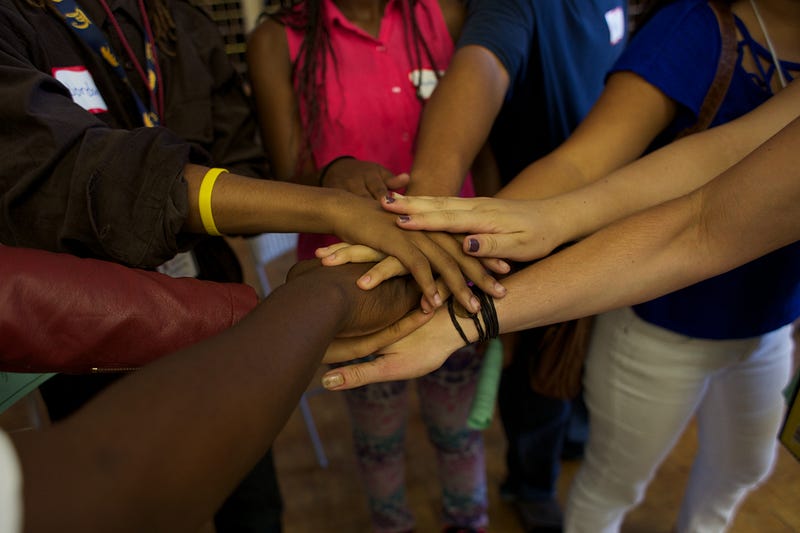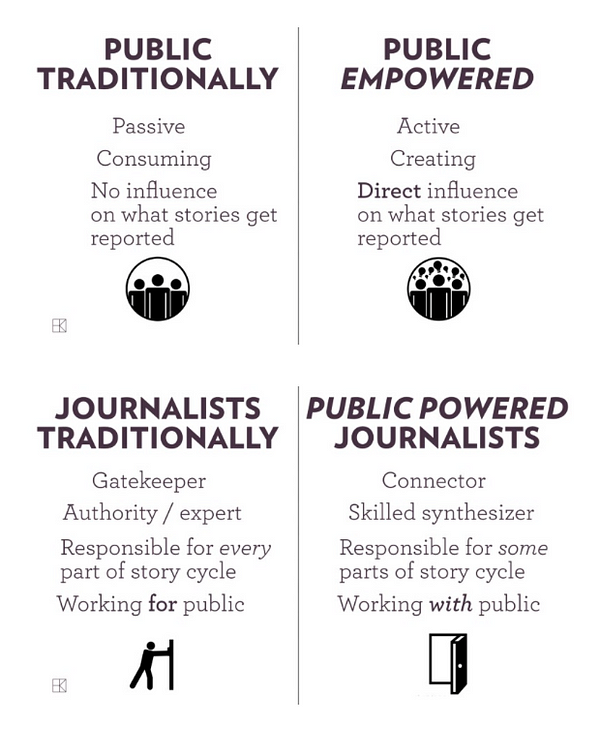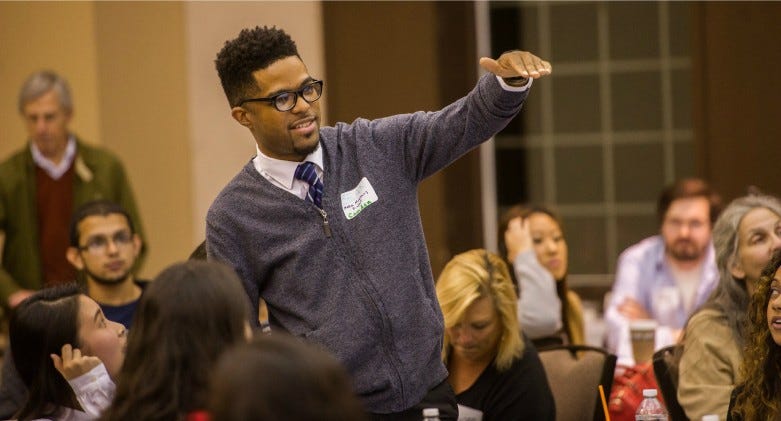February 3, 2016
Rethinking Community Engagement Inside and Outside Newsrooms
Lessons from the Local News Lab — Part Three
This is part three of six essays documenting what we have learned about building new networks for local news and fostering more creative, sustainable and community driven journalism. Read part one, and part two.
By Molly de Aguiar and Josh Stearns of the Geraldine R. Dodge Foundation

As news organizations explore alternative revenue streams — from donations and events to services and memberships, we cannot ignore that each of these models depends on developing a community of people with deep affinity for the work journalists do. Sustainability for local news is, in fact, inextricably linked with meaningful community engagement that builds relationships and renews trust with the public which, in turn, leads to securing investment from individuals, advertisers and philanthropy.
Journalism has to do a better job at listening to what communities want and need, asking what problems they are trying to solve, and designing its work to meet more of those needs. This means reimagining journalism as a service not a product. This kind of community-driven reporting does not diminish professional journalists’ role or the importance of their craft, it actually enlarges it. It also results in journalism that is more relevant and consequential to people’s lives.

A. DEMONSTRATION PROJECTS
Decades of newsroom culture run counter to the idea of participatory journalism. As we look to help newsrooms open up to their communities, we have to focus not just on developing new skills but also on shifting culture. And this leads us to an interesting question we’ve been asking ourselves: how do you get people excited about something they don’t understand or have never seen?
This is where we see an invaluable role for philanthropy — to fund demonstration projects that help journalists and the public start to see the possibilities and rewards of more collaborative, service-oriented journalism that leads to news organizations becoming vibrant community hubs.
We are approaching this challenge by looking for the best creative sparks — the most innovative and impactful community driven projects around the country — and bringing them to New Jersey to demonstrate the potential of these new reporting methods. It took us much of the first year to design these demonstration projects, aligning organizational strengths with community needs as well as lining up a multi-faceted funding collaboration around this work. In addition to Dodge and Knight, the Rita Allen Foundation and the Wyncote Foundation joined us in funding pieces of this work.
In many ways, we are in the early stages of this work — as we have noted, relationship and trust building take time — but already we found that there were three keys to encouraging newsrooms to adopt and test these new reporting models:
- First, we had to inspire them. Having a webinar with people currently involved in community reporting projects helped get our partner sites excited, imagining how they could adapt these strategies in their own communities.
- Second, we had to show that it worked. Small sites — even those that are willing to take risks — are much more likely to adopt something that is proven. They can’t afford to invest in something that will demand a lot of time and resources without a sense that it will provide some kind of pay-off.
- Third, we incentivized them by helping offset the costs of bringing on community engagement staff for two years. By the end of year two, our hope is that the engagement strategies will have yielded enough new revenue opportunities (e.g. crowdsourcing, increased advertising, events, memberships) and sufficiently broadened and deepened community ties that the news organizations will be able to, and will want, to support those staff roles themselves.
We have launched two demonstration projects in NJ:
Hearken — Hearken is a platform and a process designed to help newsrooms listen to communities and tap into their curiosity to shape stories that are immediately relevant and useful to local people.
 Slides via Jennifer Brandel at Hearken
Slides via Jennifer Brandel at HearkenThree New Jersey newsrooms launched Hearken projects: Brick City Live (“Curious Brick City”), New Brunswick Today (“ NB Today Listens”) and NJTV (“Ask Away”) with funding support from both the Wyncote Foundation and the Rita Allen Foundation in addition to Dodge and Knight. These newsrooms are some of the first in the country to adopt this platform, and it is also the first time Hearken has been used by a for-profit local newsroom, a digital only local newsroom and as a collaboration between three newsrooms. In addition, New Brunswick Today has implemented Hearken in both English and Spanish.
Hearken is also being used by the Center for Investigative Reporting in New Jersey as part of the collaborative “Dirty Little Secrets” project (which is described in more detail later).
The Listening Post — The Listening Post “uses cell phones, public signs, and roving recording devices to capture and share voices, information, and opinions.” The project, first started in New Orleans, describes its goal as creating and expanding conversations around important local issues.” Jersey Shore Hurricane News has just launched a pilot of the Listening Post to complement its social media-driven local reporting. Internews, the organization which oversees the project in New Orleans, will also be monitoring the effort and creating a toolkit for other newsrooms to set up their own Listening Posts.
B. BUILDING COMMUNITY AROUND THE NEWS
Demonstration projects are one way we’re exposing news organizations to creative ways of rethinking their work. However, changing the relationship between newsrooms and communities should not be an effort that is driven by news organizations only. It is important to us to approach this issue from the viewpoint of both journalists and the communities they serve. Therefore, we are also investing in community organizing initiatives which provide opportunities for in-depth dialogue and media training to empower people and give them the tools to engage their newsrooms. We talk about this as creating community literacy for newsrooms and news literacy for communities.
The Dodge Foundation has partnered with two organizations, Free Press and Media Mobilizing Project, to facilitate new and stronger relationships between news organizations and community members by bringing them together in town hall style forums and fostering dialogue and exploration of local issues:
- Free Press — Free Press’ “News Voices New Jersey” project is using community organizing techniques and creative community events to bring local residents together around issues that matter to them, and then exploring how journalism can play a role. So far, they have held two events with more than 200 people in attendance. Evaluations and feedback on the events were very positive from both community members and journalists. Already, in just the first six months of this work we are witnessing the impact of this work and see great potential to replicate it in other areas. This work is being funded over two years in partnership with the Democracy Fund.

- Media Mobilizing Project — MMP’s “Neighborhoods to Newsrooms” project is empowering organizations and individuals by providing media training and giving voice to community members on issues they care about, while also building better relationships with traditional newsrooms and hyperlocal press. They are currently working with Rutgers’ “Journalism for Democracy” project in New Brunswick which brings together student journalists and community groups around social justice issues; they are also working hand-in-hand with Free Press at their events.
The investments in Hearken and the Listening Post as well as the work of Free Press and Media Mobilizing Project are meant to signal the importance we place on community-led, participatory journalism as key to the sustainability of local news, beyond newsroom diversifying their revenue streams.
Our survey of projects like these happening across the country coupled with results we’re seeing in New Jersey affirm for us that people will invest in the local news, when it is clear that the local news is investing in them. However, news organizations will have to have patience, perseverance, and faith that communities will come to value and sustain their local news outlets if given the opportunity to have their voices heard, and their issues addressed in meaningful ways. As we have said before, building and deepening relationships takes time even for the most adept newsrooms.
This is part three of six essays documenting what we have learned about building new networks for local news and fostering more creative, sustainable and community driven journalism. In the next essay we’ll discuss how we have built new kinds of networks to support local news.













